|
Today, I found Ep.1 of this anime on Gyao. Though Gyao has only Ep.1 as a free content, I can watch it on my TV, the station is BS11. If you have an interest in this anime, you can watch it on crunchyroll.
I liked EP.1, so I will keep watching. The original novel (有頂天家族) is written by Morimi Tomihiko (森見登美彦). |

|
Tag: Japanese customs
Shigeyama Sensaku IV (四世茂山千作) passed away at the age of 93. He is one of the greatest Kyōgen actors. Age 93, it’s enough to pass away, but, still very sad. I loved his Kyōgen very much. 合掌.
My thought of gods.#4
I found an interesting article on the Internet. It is Who/what created the world?. On it, Japan has 1,766 votes, 33% of which has polled “God created the world” and 67% of which has polled “Big Bang created the world”.
As soon as I see it, I wonder who is “God”. For people of monotheistic religions, God is the god maybe 100%. But for us? When Japanese poll a vote, how many percents of us imagines “God” monotheists expect? Even if we read the word “God”, in our brain the word is automatically translated into “神”. When it happens, we recognize “God” as “神”. And “神” is never the One God.
Actually, for me, “神 created the world” is consistent with “Big Bang created the world”. Pay attention to the word “神”. It’s never the God. The control room of Hayabusa had an Ofuda of Chūka shrine(中和神社) and others. This is a very famous episode. The Ofuda of Chūka shrine which Dr. Kawaguchi(川口淳一郎) got from the shrine and he made a play on words linking 中和器(chūwa-ki = neutralizer) and 中和神社(Chūka-jinja). They have same kanji characters though their pronunciations are different.
He was not kidding by his act. We have the saying “Do your best and leave the rest to Providence (人事を尽くして天命を待つ)”. He did his best and there was not anything else he could. So, he did make such a play and did pray, I think. Since early times, Japanese have accepted a lot kinds of religions, but we still keep a primitive faith to Nature(自然) in our mind. When we use the word 自然, it also includes us, human-beings.
From the Meiji Restoration(1868) to the end of World War II(1945), Japanese government used Shrines (神社) as one of the tools of state administration, so shrines carry political implications now. But originally, shrines have no relationship with the government. They have long history. In some periods of the long history, they might have some relationship with the powers of the day, but they originated in our primitive faith to Nature.
We have a god everywhere, kitchen oven, bath, lavatory, etc. By the way, bath and lavatory are usually separated in Japan still now.
When Japanese are asked his/her religion, he/she often answers he/she has no religion or he/she is an atheist. You should not blindly accept it. It’s NOT true. It means he/she is not a Christian, not a Muslim, and so on. We, most of Japanese, even today, have our old gods in our mind. It is our religion.
Today, I show you my typical pleasures in spring. Two for my mouth, one for my eyes.
In Japanese, we call Equisetum arvense スギナ, and its bud 土筆. We don’t eat スギナ, but, eat 土筆 as a vegetable in spring. I took a photo of them I saw at ridges of rice fields. These 土筆 are short and look older for me. I prefer younger 土筆 which are slightly bitter because of their spores.
We also eat 芹 as a vegetable. The photo is the dish called 白和え. 白和え is like a salad dressed with tofu, white sesame, and miso.
And well-known 桜.
They are my pleasures in spring. But, this spring has brought a trouble to me, too. Allergy symptoms such as a runny nose and sneezing. Sigh.
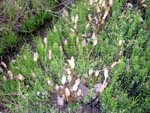 |
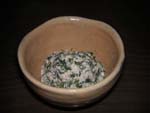 |
 |
Hi, guys, I found this article on the Net, which the original author seems to have written in 2004 April. At my reading, I was in stitches. I want to share this experience with you, so translate it (^o^). Can you get what fun this is by my translation? Well, I’ll try it……
Let’s read the translation of “Programming language ‘Japanese'”.
* [1][2] in the following text are added by me.
————————————————————————————————————————————————
|
Programming language
“Japanese”
●
April 2004
Leshade Entis |
||
|---|---|---|
|
■ Introduction |
||
|
Japanese is one of the oldest classes of programming languages in the world, which was invented by the ancient Jomon1 people about 10,000 years ago. (※) ※ If I write just to be sure, this document is an attempt to say a commentary as the programming language “Japanese”, and have fun clarifying the meaning of the words we usually use without considering. |
||
|
■ Disclaimer |
||
|
Please use this software under your responsibility. I have no responsibility for the damage caused by the software. |
||
|
■ Outline of the programming language “Japanese” |
||
|
“Japanese” has the following features. ◆ Powerful macro
A lot of particles and auxiliary verbs characterize some features of Japanese. |
||
|
Original: I feel blue. |
||
|
◆ Flexible syllable structure
Japanese syllables are considerably simplified and their combination has a lot of flexibility, which is one of Japanese features. |
||
|
Example: はにゃ~~~ん |
||
|
This feature is very powerful, so you can consist a statement only using mimetic words combined with macro. (※) |
||
|
Example: ごぉごぉざぁざぁびゅうびゅうの中を、とぼとぼ行ってたら、ふにゅ~~でぬめぇ~~~っとしたのがうじゃうじゃしてたし、さっきはブーブーがダー、バ シャっで、もうびしょびしょでくたくたで、ふえぇ~~~~んって感じ。 |
||
|
※ Heavy use of mimetic words usually gives lower-class impression, but, you’ll find the interesting thing when writing down everyday conversation into sentences. |
||
|
◆ Advanced abstraction and hiding
Japanese can describe the state of one’s mind and delicate things, on the contrary, it can make an abstract description for the subject. |
||
|
■ Main syntax |
||
|
I’ll explain the syntax that is often used in Japanese. ◆ “dōmo (どうも)” There are various usage “dōmo (どうも)”. <dōmo statement>
The statement consists of only “dōmo” is called “dōmo statement” and doesn’t do anything. |
||
|
Example: どうも、どうも。 |
||
|
<dōmo prefix>
By writing “dōmo” to the beginning of the statement, you can run its following statements in a special synchronization state. |
||
|
Example: どうも、すいません。 |
||
|
<Variable or function name>
You can use “dōmo” as a variable or a function name that don’t have a special meaning. <Type about “dōmo”>
“dōmo” does not identify the type. ◆ “yoroshiku (よろしく)” “yoroshiku” is an instruction that tells the act accordingly. |
||
|
どうも、よろしく。 |
||
|
a function and this statement are equivalent. The function automatically selects a procedure set to realize what an object wants. The object is assigned to the “dōmo” pointer and itself knows what it wants. Then, it runs in a state of maintaining synchronization “dōmo synchronization”. ◆ “īimide (良い意味で)”
“īimide” is a kind of pseudo-instruction. |
||
|
Example: 良い意味で競争する。 |
||
|
◆ “osewaninatteorimasu (お世話になっております)”
“osewaninatteorimasu” is a kind of declaration statement, to which a compiler feels obliged. ◆ “shitsureishimasu (失礼します)”
“shitsureishimasu” is a kind of declaration statement, which you should declare in advance when you might be rude. ◆ “otsukaresamadesu (お疲れ様です)”
“otsukaresamadesu” is a kind of declaration statement. ◆ “moshi (もし)”
If you want to write a “moshi” statement, you use this with conditional options in advance. ◆ “kentōshitemimasu (検討してみます)”
“kentōshitemimasu” statement spools the tasks. ◆ “tameshitemimasu (試してみます)”
“tameshitemimasu” is a kind of declaration statement, which you should declare in advance when you code a procedure set which might return a lot of errors. ◆ Final particles, “wa (わ)” “ne (ね)” “aru (アル)” “nyo (にょ)”, etc.
In Japanese, you can describe a final particle at the end of the statement. |
||
|
Examples: |
||
|
■ The helpful knowledge in Japanese programming |
||
|
Last of all, I’ll write some helpful knowledge in Japanese programming. ◆ Describe expressions vaguely
In Japanese programming, to describe an expression exactly is senseless. ◆ Out of sight, out of mind
Generally, you should not write that it is considered “evil”. ◆ Attempt a description by passive form
Modern times, in particular today, the mainstream of Japanese programming is the description by passive form. ◆ Not adding spaces between the words
You never add spaces between the words, with an emphasis on readability. ◆ Syntax error is recommended
If you don’t know how to describe exactly, you try to describe it without thinking. Copyright (C) 2004 Leshade Entis. All rights reserved. |
||
————————————————————————————————————————————————
The original article title is “プログラミング言語「日本語」” by Leshade Entis. He is surely a native Japanese speaker, I think. If you have feelings of curiosity, visit and read it in Japanese!!
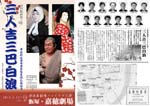 Today, I saw the kabuki play “Sannin Kichisa Tomoe no Shiranami(三人吉三巴白浪)” at Kaho Gekijō(嘉穂劇場), which is one of traditonal Japanese theaters in existence.
Today, I saw the kabuki play “Sannin Kichisa Tomoe no Shiranami(三人吉三巴白浪)” at Kaho Gekijō(嘉穂劇場), which is one of traditonal Japanese theaters in existence.
Nowadays, the theaters in Japan have chairs. But the old theaters in Japan had no chairs, and the audience sat on the floor with cushions(座布団). And they had Hanamichi(花道) and Suppon(スッポン), etc. Kaho Gekijō(嘉穂劇場) still has such styles.
The play started at 13:30 and ended at around 16:30. It took almost 3 hours and was a full-length play(通し狂言). But, I did not feel too long. I’ve ever heard the original scripts was very longer than the play in today.
The story is very complicated. If you have curiosity, please read this. (´∀`)
Hatsumōde(初詣) five days late.
Update information Edit(Jan.7)
Today, I visited Takasumi jinja(高住神社) as the Hatsumōde(初詣) five days late. Around the shrine the snow stuck to the ground, and the temperature was -2℃ around 2p.m. I drew omikuji and bought the Tengu(天狗) version Hikosan garagara as a charm to ward off evil spirits for my house.
I’ll show you some photos. Take a look!!
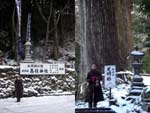 |
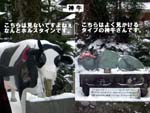 |
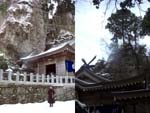 |
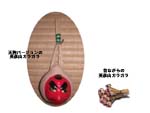 |
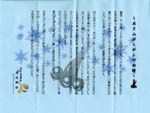 |
Edit(Jan.7):
I found this on the Takasumi jinja official blog. I drove the very same route yesterday, although less piling and more compacted.
Momijigari(紅葉狩)
These days, autumn is at its height and the leaves are at their peak color in Japan. When I came back to Japan, I always wanted to go to Momijigari(紅葉狩). But, weather is good when I have no time, I have free time when weather is bad. So, my visit was delayed about for a week. Last weekend, weather was bad again.
Today, it was from cloudy to sunny. I went to the mountain I sometimes wrote about here. For years, when I go there, I only visit Hōheiden(奉幣殿), today I decided to call on Takasumi jinja(高住神社). It is also called Buzenbō(豊前坊). Eight Tengu(八天狗) of Buzenbō(豊前坊) are famous in the past, and they are written in Noh(能) “Kurama(鞍馬)” a little.
By the way, I saw autumn leaves are very beautiful. I share some of them with you!!
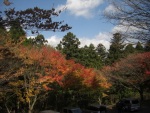
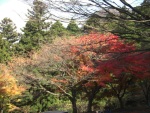

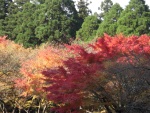





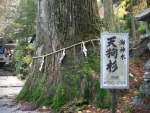

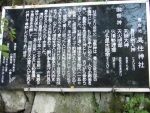
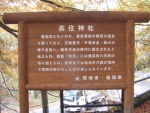
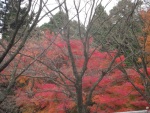




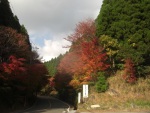
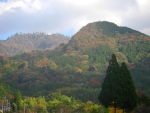
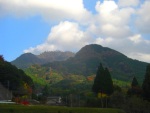
Reading 雨月物語 aloud.
Recently, I make an audio book for my private net radio station (It doesn’t exist anymore – 2016.Jun.1) which is my reading of “Ugetsu monogatari (雨月物語)”.
There is a big difference between to read aloud and to read silently in Japanese. The difference between the two might exist in other languages. But a unique problem for us, we have the different readings of a word written by Chinese characters (漢字). When we, i.e. grown-up Japanese, read a sentence silently, we don’t mind if we don’t know its pronunciation of a word written by Chinese characters. Chinese character is an ideogram, each of them has meanings itself. Besides, a book for grown-ups has no Furigana (ふりがな). So, we can get what the writer say, but we cannot know how to pronounce of the writer calling to mind.
“Ugetsu monogatari” is one of Ueda Akinari’s works. Ueda Akinari (上田秋成) was in 18th century. “Ugetsu monogatari” is, so to speak, a collection of Japanese ghost stories.It is not a simple horror book but a dreadful elegant one. If you were Japanese, you could enjoy not only its contents but its style. The original text has good rhythm. If a good reader did aloud, it would become a good audio book. And we have such CDs in Japan.
Of cource, I’m NOT a good reader, so it is a reckless challenge. But I dare to do it. (++;)
Adachigahara(安達原)
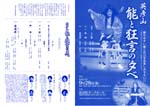 On Sep. 28, I saw Noh(能) “Adachigahara(安達原)” at the Hall nearby. At the same time, they staged Kyōgen(狂言) “Bōshibari(棒縛り)”, and Noh “Futarishizuka(二人静)” as an opening act(舞囃子). In 舞囃子, actors have no mask and perform a main part of the Noh play.
On Sep. 28, I saw Noh(能) “Adachigahara(安達原)” at the Hall nearby. At the same time, they staged Kyōgen(狂言) “Bōshibari(棒縛り)”, and Noh “Futarishizuka(二人静)” as an opening act(舞囃子). In 舞囃子, actors have no mask and perform a main part of the Noh play.
Three plays were performed in the order below.
- Futarishizuka(二人静)
- Bōshibari(棒縛り)
- Adachigahara(安達原)
Though I often go and see Kyōgen, this is the first live Noh play I have ever seen. Noh is very closely related with Kyōgen and their history is similar in length. But nowadays, we have less chance of seeing Noh than seeing Kyōgen. This time, we had no famous actors in the performers, but they were good shows.
By the way, actually I love Kyōgen than Kabuki. And, only “Bōshibari(棒縛り)” I can find on YouTube. Please click the link and enjoy it!!